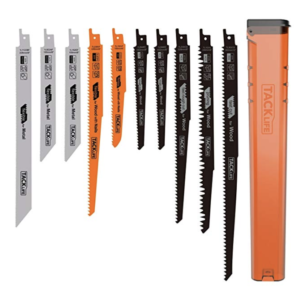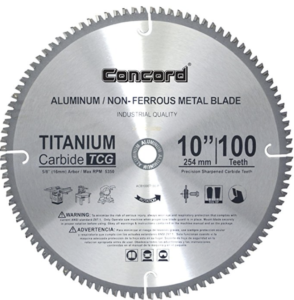Which saw blade is going to be right for me?
With all the different types of saw blades out there on the market, I have always wandered if I was choosing the right type of saw blade for my projects in the past. I know that you need a certain type of blade depending on the material you are sawing through. In this article, we will be mainly talking about circular saw blades and reciprocating saw blades, beings those are the mostly used portable power tools involving sawing.

You need to always remember and ask yourself a few things first before just deciding on a certain type or brand of saw blades.
- What materials can this blade cut through? Example: Softer materials like wood, PVC, rubber, drywall, can be cut using a wood saw blade.
- What specific style of saw is being used? Example: You do not want to purchase a circular saw blade and try attaching it to your reciprocating saw.
- How powerful does the blade need to be? Example: Certain style of blades contain different manufacturing principles, such as your standard concrete radial saw, it contains diamond tipped edges, to give it superior strength when cutting through very dense and hard materials.
Knowing these things up front will help you tremendously. Different styles and types are going to play a hug role in the saw blade purchase process. Blades can be from cutting lumber, drywall on a project or job, or hardened steel style blades for cutting thin metals such as sheet metal.
Other factors to remember that make a saw blade unique, is the size of the gullet, tooth configuration, hook angle, and size of the teeth themselves. Generally speaking, the more teeth that are present on a saw blade, will indicate a much smoother cut compared to fewer teeth. The gullet is how deep or wide the space in from of each tool will allow for the chip removals. The bigger the gullet, the quicker it could rip up and spit out material as it is cutting through.
Types Of Saw Blades In General
Rip Blades – These are the most common types of saw blades sold on the market. They are mainly used when cutting into grain aligned pieces of wood, and often produce fine, smooth cuts and typically because of the hook angle, cut faster.
Crosscut Blades – Saw blades used for wood work, or against the grain style cuts, that require delicate, precise cuts, typically do not cut as fast as a rip blade, but produce a better result.
Finishing Blades – These saw blades will contain way more teeth than your typical cutting blade. They are used for applications and materials that are already finished, meaning the cut needs to be fine and not damaging to the edges of the material its cutting on. Typically wall panels, plywood, or thin types of wood.
Nail Cutting Blades – saw blades that are used on repurposed wood, or materials that already had the existence of nails in them. You want to use these styles because it will not damage the blade or the wood, when you start to cut and find a nail or screw. It will cut through just fine with no issues what so ever.
Metal Cutting Blades – Lower hook angle styles, made of hardened steel, that is designed to take the heat that is generated from the friction produced when a metal cut is being made. Steel piping, sheet metal, or thick pieces of flat iron or steel is what you will typically cut using these style of blades. When I purchase my metal blades on Amazon, I make sure they are made of titanium carbide.

Dry Diamond Blades – Concrete, porcelain, or ceramics, or any style of masonry work, that requires a strong carbide style blade, that cuts slowly, precisely, and effectively. Producing a cut that will be perfect.
Dado Cutting Blades – are used mainly on radials or table saws. They cut grooves or dados, but can be cut moldings into already cut pieces or wood.
What are the different types of teeth on a saw blade?
Depending on the material these saw blades will be cutting will determine. These are very dangerous pieces of a tool, because of how sharp, vicious, and destructive that saw blade is. Here are a few variations of what type of teeth could be included on your saw blades.
- Flat Top – style teeth on saw blades are used for softer materials such as soft woods that will not be visible, and or will be replaced at some point.
- ATB or Alternate Top Bevel – means that the saw blade teeth will alternate between right and left hand bevels. The outcome of using these styles is for a smooth cut when you have to cross cut natural and fine woods and plywood. It makes a great clean cut.
- Combination Tooth (Comb Style) – These combination style saw blade teeth are designed to do a both crosscutting and ripping. Arranged typically in groups of five (4 ATB and one FT) they also contain large deep gullets between the groupings of teeth.
- Triple Chip Grind (TCG) – these saw blades are the best for harder materials such as PVC, plastic floor coverings, and other types of plastics that alternate a flatter “rake” style and a higher trapeze tooth. They can also be used for non-ferrous metal cutting blades as well.
What is a saw blades hook angle?
Not all saw blades are created equally, because there are so many different factors involved. But you also need to take into consideration the job you are going to perform. You will see that some saw blades do not have a straight and uniform flat teeth arrangement. Some saw blades the teeth will angle forward or backwards at different degrees. This is the hook angle. If you wanted an aggressive and fast feed rate cut, you would want a saw blade that had a positive or (forward) hook angle. Most table saws, or circular saws, will have blades with these styles. Because the blade can cut faster, and spit out the material its cutting through at a faster rate. A low or negative hook angle would be for those finer, more precise cuts. Metal, concrete, any dense or hard surfaces that need that extra step or care when cutting. If you didn’t have these styles, it could bind or break your saw blade, or also damage the material you were trying to cut in the first place. Band saws, or reciprocating saws that have saw blades cutting metal would more than likely have a low or negative hook angle.
Saw Blade Teeth Quality
All saw blades can be manufactured differently, some have high quality carbide tips, diamond tips, or hardened steel tips, the can be made into the saw, brazed to the steel plating. All of these factors will tell you how long and sharp the blade will last, and this will also affect the price. Some saw blades can not be resharpened at all, because the material present is so thin and delicate, you will end up grinding or cutting the saw blade teeth clean off. I would always recommend to someone to purchase the better quality titanium carbide saw blades, because they are more efficient, quieter, and stay sharp longer. Then, after prolonged use, if you needed to resharpen the saw blades, you can do so about 4 or 5 more times.
Conclusion
We did a ton of research, and learned tons along the way. It is always very important to remember that you need to always try to choose the best type of blade you can depending on the project. Saw blades are very expensive, and I understand that you can’t just go out and immediately stock up on all style and types. At first, when I started doing projects, I started with my reciprocating saw. That was the saw, at the time, I used most. I love that saw, and I knew that I needed to try and keep at least a wood and metal style blade, but I found that most of the time, when I was using my reciprocating saw, I only needed to remove something or to “demolish” materials on a car, boat, house, etc. When I started taking on the hobby or building furniture, I first invested in wood cutting, because that was the material I would cut using my circular and table saws. As time progressed I would slowly start to build an arsenal of different types and styles of saw blades I could find. I would always purchase my circular saw blades on amazon, and have them shipped directly to my door. This way, I didn’t have to drive or hunt things down in different aisles at Lowes. Saved me both time and money. I also learned very early on, that it was smart to invest in some type of gloves, or long reach sticks, to push material through my table saw. Use proper eye protection as well, so you aren’t having a long splinter removed from your eye.
